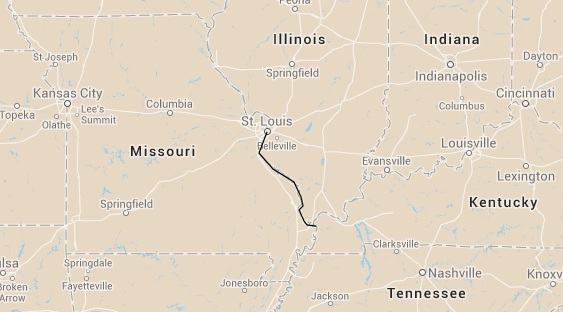
v. The valley of the Mississippi ...
The valley of the Mississippi illustrated in a series of views.
Illustrations by J. C. Wild.
Text by Lewis Foulk Thomas.
St. Louis, Mo.: Published by the artist, 1841-1842.
9 parts (vi, [7]-145 pages); 27 [i.e. 31], [4] leaves of plates (4 folded); illustrations (lithographs); 30 cm -- Originally issued monthly in 9 numbers from July 1841 to March 1842. -- Illustrations include black-and-white chalk lithograph plates and vignette on title page of first number. -- Brown leather spine with marbled cover boards; gilt lettering on spine. -- Library catalog record.
Click here for the entire book.
John Caspar Wild was born in Zurich in 1804. He worked as an artist in Paris for several years before immigrating to the United States in 1831 or 1832. Wild was active as a painter and lithographer specializing in landscape and urban views in Philadelphia and Cincinnati during the 1830s.
Wild moved to St. Louis in 1839, when he was 35 years old. Over the next year, he painted several gouache views of St. Louis that he showed to entice the public to subscribe to a series of corresponding color lithographs. Wild issued two editions of Views of St. Louis before expanding the project into a series of black-and-white lithographs titled The Valley of the Mississippi. Wild asked Lewis Foulk Thomas, who had established a reputation writing about the West, to provide the accompanying text. Thomas would later publish a book of poems about the Mexican-American War.
The Valley of the Mississippi was issued in nine numbers from July 1841 to March 1842. The November and December issues were delayed due to the death of Wild's twenty-year-old wife Sarah Ann Humphreys: they had been married only four months. The series covers the towns and natural features along the section of the Mississippi between the Ohio and Missouri Rivers.
In 1844, Wild decided to paint scenes of the upper portion of the Mississippi, making his way as far as Fort Snelling in Minnesota. Wild intended to settle in Davenport, Iowa when he died there in 1846 after a lengthy illness. He was 42 years old and engaged to be married to Mary Jane Webb. Wild never enjoyed financial success in any of his endeavors, but he was plagiarized during his life and after his death. One offender was Henry Lewis, who two years after Wild's death began a moving panorama project that eventually became Das Illustrirte Mississippithal. At the age of 82, Lewis donated an oil painting to the Missouri Historical Society. He said the painting was based on sketches he made in 1847-1848 for the panorama. The composition of the painting exactly replicates that of a lithograph by Wild published in 1840.
---Written by Mary Z. Rose
References consulted for exhibition text:
Groce, George C. and David H. Wallace. The New-York Historical Society's Dictionary of Artists in America, 1564-1860. New Haven: Yale University Press, 1957. (Library catalog record.)
McDermott, John Francis. "J. C. Wild, Western Painter and Lithographer." Ohio State Archaeological and Historical Quarterly. 60.1 (1951): 111-125. Online access is unrestricted.
Reps, John W. John Caspar Wild: Painter and Printmaker of Nineteenth-Century Urban America. St. Louis: Missouri Historical Society Press, 2006. (Library catalog record.)